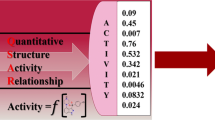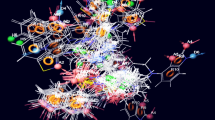Abstract
Some important atypical antipsychotic drugs target the serotonergic receptor 2A (5-HT2AR). Currently, new therapeutic strategies are needed to offer faster onset of action with fewer side effects and, therefore, greater efficacy in a substantial proportion of patients with neuropsychological disorders such as Autism and Parkinson. The main objective of this work was to use SBDD methods to identify new hit compounds potentially useful as precursors of novel and selective 5-HT2AR antagonists. A structure-based pharmacophore screening study based on a selective antagonist was carried out in ten databases. The set obtained was refined using molecular docking, and the five most promising compounds were subjected to molecular dynamics simulations. The most stable and promising hit occupied a side pocket present in the 5-HT2AR, a site that can be explored to obtain selective ligands. Simulations against 5-HT2CR and D2R showed that the best hit could not form stable complexes with these targets, strengthening the hypothesis that the hit presents selective binding by the receptor of interest. The selected hits showed some predicted toxicity risk or violated some drug-likeness property. However, it can be concluded that the identified hits are the most promising for performing in vitro assays. Once the presence of activity is confirmed, they could become precursors of optimized and selective antagonists of 5-HT2AR.
Graphical abstract
An SBDD study was carried out to identify new selective 5-HT2AR ligands potentially useful for designing selective atypical antipsychotics.















Similar content being viewed by others
References
Tordjman S, Najjar I, Bellissant E et al (2013) Advances in the research of melatonin in autism spectrum disorders: literature review and new perspectives. Int J Mol Sci 14:20508–20542. https://doi.org/10.3390/ijms141020508
Eissa N, Al-Houqani M, Sadeq A et al (2018) Current enlightenment about etiology and pharmacological treatment of autism spectrum disorder. Front Neurosci 12:304. https://doi.org/10.3389/fnins.2018.00304
Chen X, Sun Y, Fu L et al (2016) Synthesis and pharmacological characterization of novel N-(trans-4-(2-(4-(benzo[d]isothiazol-3-yl)piperazin-1-yl)ethyl)cyclohexyl)amides as potential multireceptor atypical antipsychotics. Eur J Med Chem 123:332–353. https://doi.org/10.1016/j.ejmech.2016.07.038
Kimura KT, Asada H, Inoue A et al (2019) Structures of the 5-HT2A receptor in complex with the antipsychotics risperidone and zotepine. Nat Struct Mol Biol 26:121–128. https://doi.org/10.1038/s41594-018-0180-z
Zhang G, Stackman Jr RW (2015) The role of serotonin 5-HT2A receptors in memory and cognition. Front Pharmacol 6:225. https://doi.org/10.3389/fphar.2015.00225
Radan M, Ruzic D, Antonijevic M, Djikic T, Nikolic K (2021) In silico identification of novel 5-HT2A antagonists supported with ligand-and target-based drug design methodologies. J Biomol Struct Dyn 39:1819–1837. https://doi.org/10.1080/07391102.2020.1738961
Casey AB, Cui M, Booth RG, Canal CE (2022) “Selective” serotonin 5-HT2A receptor antagonists. Biochem Pharmacol 200:115028.https://doi.org/10.1016/j.bcp.2022.115028
Bell C, Wilson S, Nutt DJ (1998) Pindolol augmentation of sertraline in resistant depression and its effect on sleep. J Psychopharmacol 12:105–107
American Psychiatric Association (2013) Diagnostic and Statistical Manual of Mental Disorders (DSM–5), 5th edn. American Psychiatric Publishing, Washington
Wing L, Gould J (1979) Severe impairments of social interaction and associated abnormalities in children: epidemiology and classification. J Autism Dev Disord 9:11–29. https://doi.org/10.1007/bf01531288
Wing L, Potter D (2002) The epidemiology of autistic spectrum disorders: is the prevalence rising? Ment Retard Dev Disabil Res Rev 8:151–161. https://doi.org/10.1002/mrdd.10029
Leonard H, Glasson E, Nassar N et al (2011) Autism and intellectual disability are differentially related to sociodemographic background at birth. PLoS ONE. https://doi.org/10.1371/journal.pone.0017875
Parner ET, Schendel DE, Thorsen P (2008) Autism prevalence trends over time in Denmark: changes in prevalence and age at diagnosis. Arch Pediatr Adolesc Med 162:1150–1156. https://doi.org/10.1001/archpedi.162.12.1150
Hallmayer J, Cleveland S, Torres A et al (2011) Genetic heritability and shared environmental factors among twin pairs with autism. Arch Gen Psychiatry 68:1095–1102. https://doi.org/10.1001/archgenpsychiatry.2011.76
Risch N, Hoffmann TJ, Anderson M et al (2014) Familial recurrence of autism spectrum disorder: evaluating genetic and environmental contributions. Am J Psychiatry 171:1206–1213. https://doi.org/10.1176/appi.ajp.2014.13101359
Bauman ML, Kemper TL (2005) Neuroanatomic observations of the brain in autism: a review and future directions. Int J Dev Neurosci 23:183–187. https://doi.org/10.1016/j.ijdevneu.2004.09.006
Ghosh A, Michalon A, Lindemann L et al (2013) Drug discovery for autism spectrum disorder: challenges and opportunities. Nat Rev Drug Discov 12:777–790. https://doi.org/10.1038/nrd4102
Canitano R, Scandurra V (2011) Psychopharmacology in autism: an update. Prog Neuropsychopharmacol Biol Psychiatry 35:18–28. https://doi.org/10.1016/j.pnpbp.2010.10.015
Martin C, Zhang Y (2007) Mechanisms of epigenetic inheritance. Curr Opin Cell Biol 19:266–272. https://doi.org/10.1016/j.ceb.2007.04.002
Clarivate Analytics Integrity (2022) https://integrity.clarivate.com/integrity/xmlxsl. Accessed 24 April 2022
Froimowitz M (1993) HyperChem: a software package for computational chemistry and molecular modeling. Biotechniques 14:1010–1013
Chen X, Sun Y, Fu L et al (2016) CCDC 1414993: experimental crystal structure determination. https://doi.org/10.5517/ccdc.csd.cc1jhdyc.
Trott O, Olson AJ (2010) AutoDock Vina: improving the speed and accuracy of docking with a new scoring function, efficient optimization, and multithreading. J Comput Chem 31:455–461. https://doi.org/10.1002/jcc.21334
PyRx (2022) Virtual screening software for computational drug discovery. https://pyrx.sourceforge.io/home. Accessed 24 April 2022
Dallakyan S, Olson AJ (2015) Small-molecule library screening by docking with PyRx. Methods Mol Biol 1263:243–250. https://doi.org/10.1007/978-1-4939-2269-7_19
Sulimov VB, Kutov DC, Taschilova AS et al (2021) Docking paradigm in drug design. Curr Top Med Chem 21:507–546. https://doi.org/10.2174/1568026620666201207095626
BIOVIA Discovery Studio Visualizer (2022) https://discover.3ds.com/discovery-studio-visualizer-download. Accessed 24 April 2022
Rodrigues RP, Mantoani SP, de Almeida JR et al (2012) Virtual screening strategies in drug design. Rev Virtual Quim 4:739–776. https://doi.org/10.5935/1984-6835.20120055
Sunseri J, Koes DR (2016) Pharmit: interactive exploration of chemical space. Nucleic Acids Res 44:W442–W448. https://doi.org/10.1093/nar/gkw287
Vyas V, Ain AJ, Gupta A (2008) Virtual screening: a fast tool for drug design. Sci Pharm 76:333–360. https://doi.org/10.3797/scipharm.0803-03
Muhammed MT, Aki-Yalcin E (2021) Pharmacophore modeling in drug discovery: methodology and current status. J Turk Chem Soc A 8:749–762. https://doi.org/10.18596/jotcsa.927426
Koes DR (2018) The Pharmit backend: a computer systems approach to enabling interactive online drug discovery. IBM J Res Dev 62:3:1-3:6. https://doi.org/10.1147/JRD.2018.2883977
Lin X, Li X (2020) A review on applications of computational methods in drug screening and design. Molecules 25:1375. https://doi.org/10.3390/molecules25061375
Schreiner W, Karch R, Knapp B et al (2012) Relaxation estimation of RMSD in molecular dynamics immunosimulations. Comput Math Methods Med 2012:173521. https://doi.org/10.1155/2012/173521
Schrödinger. Simulation Interactions Diagram (2022) https://www.schrodinger.com/newsletters/introducing-sid-simulation-interactions-diagram. Accessed 24 April 2022
Wacker D, Wang C, Katritch V et al (2013) Structural features for functional selectivity at serotonin receptors. Science 340:615–619. https://doi.org/10.1126/science.1232808
Harder E, Damm W, Maple J et al (2016) J Chem Theory Comput 12:281–296. https://doi.org/10.1021/acs.jctc.5b00864
Holland Computer Center (2022) https://hcc.unl.edu. Accessed 24 April 2022
Schrödinger Release 2022-1 (2022) Maestro, Schrödinger LLC. https://www.schrodinger.com/products/maestro. Accessed 24 April 2022
Peng Y, McCorvy JD, Harpsøe K et al (2018) 5-HT2C receptor structures reveal the structural basis of GPCR polypharmacology. Cell 172:719–730. https://doi.org/10.1016/j.cell.2018.01.001
Wang S, Che T, Levit A et al (2018) Structure of the D2 dopamine receptor bound to the atypical antipsychotic drug risperidone. Nature 555:269–273. https://doi.org/10.1038/nature25758
Sastry GM, Adzhigirey M, Day T et al (2013) Protein and ligand preparation: parameters, protocols, and influence on virtual screening enrichments. J Comput Aid Mol Des 27:221–234. https://doi.org/10.1007/s10822-013-9644-8
Harder E, Damm W, Maple J et al (2016) OPLS3: a force field providing broad coverage of drug-like small molecules and proteins. J Chem Theory Comput 12:281–296. https://doi.org/10.1021/acs.jctc.5b00864
LigPrep. https://www.schrodinger.com/products/ligprep. Accessed 16 Oct 2022
Banerjee P, Eckert AO, Schrey AK et al (2018) ProTox-II: a webserver for the prediction of toxicity of chemicals. Nucleic Acids Res 46:W257–W263. https://doi.org/10.1093/nar/gky318
Daina A, Michielin O, Zoete V (2017) SwissADME: a free web tool to evaluate pharmacokinetics, drug-likeness and medicinal chemistry friendliness of small molecules. Sci Rep 7:42717
VEGA QSAR. https://www.vegahub.eu/portfolio-item/vega-qsar. Accessed 16 Oct 2022
Cassano A, Manganaro A, Martin T, Young D, Piclin N, Pintore M, Bigoni D, Benfenati E (2010) CAESAR models for developmental toxicity. Chem Cent J 4(Suppl 1):S1–S4. https://doi.org/10.1186/1752-153X-4-S1-S4
The ANTARES project: Alternative Non-Testing methods Assessed for REACH Substances. https://www.deib.polimi.it/eng/research-projects/details/139. Accessed 26 Oct 2022
Stahl SM (2016) Mechanism of action of pimavanserin in Parkinson’s disease psychosis: targeting serotonin 5HT2A and 5HT2C receptors. CNS Spectr 21:271–275. https://doi.org/10.1017/s1092852916000407
Hopkins AL, Keserü GM, Leeson PD, Rees DC, Reynolds CH (2014) The role of ligand efficiency metrics in drug discovery. Nat Rev Drug Discov 13: 106-121. https://doi.org/10.1038/nrd4163
Lipinski CA, Lombardo F, Dominy BW et al (1997) Experimental and computational approaches to estimate solubility and permeability in drug discovery and development settings. Adv Drug Deliv Rev 23:3–26. https://doi.org/10.1016/s0169-409x(00)00129-0
Rishton GM (2003) Nonleadlikeness and leadlikeness in biochemical screening. Drug Discov Today 8:86–96. https://doi.org/10.1016/s1359644602025722
Antoine D, Vincent Z (2016) A BOILED-Egg to predict gastrointestinal absorption and brain penetration of small molecules. ChemMedChem 11:1117–1121
Baell JB, Holloway GA (2010) New substructure filters for removal of pan assay interference compounds (pains) from screening libraries and for their exclusion in bioassays. J Med Chem 53:2719–2740. https://doi.org/10.1021/jm901137j
Bruns RF, Watson IA (2012) Rules for identifying potentially reactive or promiscuous compounds. J Med Chem 55:9763–9772. https://doi.org/10.1021/jm301008n
Acknowledgements
E.B.M. thanks to National Council for Scientific Research (CNPq) for the Productivity Grant Level 2. All authors gratefully acknowledge the computing resources provided by the University of Nebraska Lincoln’s Holland Computing Center, the startup funds from UNMC (M.C.-S.), and Araucária Foundation. A.F.M. thanks to Pharmaceutical Sciences Graduate Program at UNIOESTE (PCF-UNIOESTE). In addition, the final assembly of Figs. 3, 7, 8, 9, 10, and 13 were created using BioRender.com platform.
Funding
CNPq (process 311048/2018-8); Fundação Araucária (grant 2010/7354); Startup funds from UNMC.
Author information
Authors and Affiliations
Contributions
All authors (A.F.M., L.J.C.; M.C-S., E.B.M.) contributed equally to the study, through periodic meetings to discuss the study data.
Corresponding author
Ethics declarations
Conflict of interest
The authors have no relevant financial or nonfinancial interests to disclose.
Additional information
Publisher's Note
Springer Nature remains neutral with regard to jurisdictional claims in published maps and institutional affiliations.
Supplementary Information
Below is the link to the electronic supplementary material.
Rights and permissions
Springer Nature or its licensor (e.g. a society or other partner) holds exclusive rights to this article under a publishing agreement with the author(s) or other rightsholder(s); author self-archiving of the accepted manuscript version of this article is solely governed by the terms of such publishing agreement and applicable law.
About this article
Cite this article
Martins, A.F., de Campos, L.J., Conda-Sheridan, M. et al. Pharmacophore modeling, molecular docking, and molecular dynamics studies to identify new 5-HT2AR antagonists with the potential for design of new atypical antipsychotics. Mol Divers 27, 2217–2238 (2023). https://doi.org/10.1007/s11030-022-10553-y
Received:
Accepted:
Published:
Issue Date:
DOI: https://doi.org/10.1007/s11030-022-10553-y




